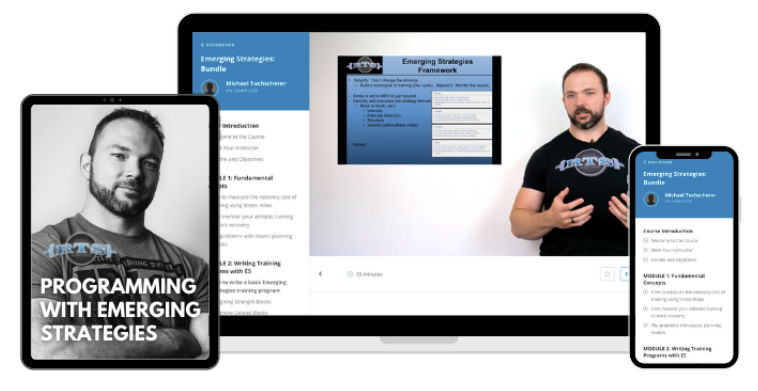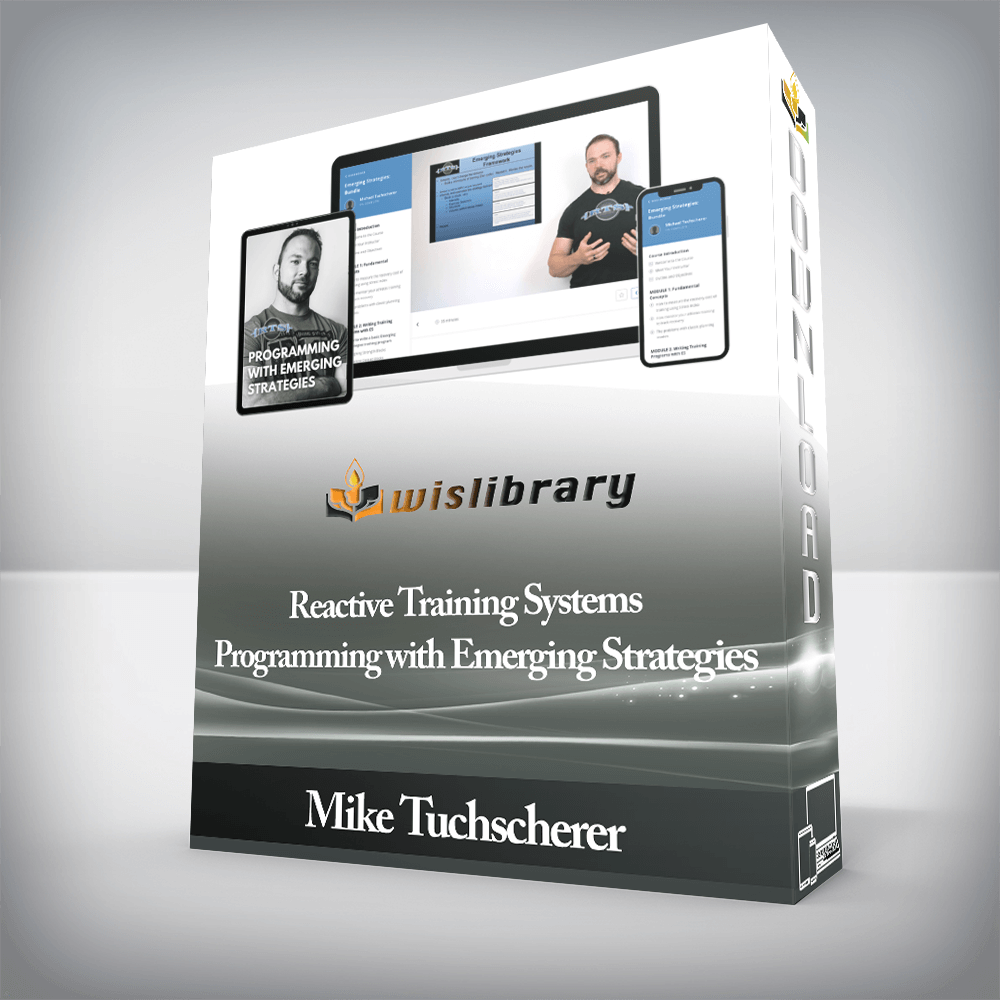Mike Tuchscherer – Reactive Training Systems – Programming with Emerging Strategies

OPTIMIZE YOUR TRAINING PROGRAM and take the guesswork out of making progress.
Imagine if you…
-
Could write training that adapts to each athletes individual needs and training response
-
Were able to develop individualized training for lifters at all levels and felt more confidence when a client asks “why”
-
Had a tried and tested method to reduce your blind spots and write custom training that delivers on its promise.
If any of this sounds like useful skills to have as a coach, keep reading…
Let us introduce you to Programming with Emerging Strategies
If you’re ready actually LEARN about strength and not just be told what to do..
YOU’RE IN THE RIGHT PLACE.
Emerging Strategies gives coaches and self coached athletes the toolset to develop training that is as close to ideal as possible.
Writing an effective training program for your clients or for yourself doesn’t have to feel like guesswork.
When you program with Emerging Strategies…
Lacking a process for knowing what’s actually working and what’s not.
Writing effective training programs independent of who you’re writing them for.
Being held back by the numerous problems with periodization science, science in general, and even the philosophical underpinnings of top-down planning models.
Understanding the problems with traditional periodization and how to solve them using an athlete centric system for writing training that encourages adaptability and flexibility.
Making uninformed decisions and letting your biases get in the way of writing an athlete centric training program.
Knowing the best way to prep your athletes, whether they’ve got a meet coming up or are in the middle of off season.
If you’re ready to improve your ability to write training, coach, and develop your lifters with a bit of help from someone who’s been there done that to guide the way..
Programming with Emerging Strategies is for you!
The program for coaches and self-coached athletes who want to get the most out of their training.
So, what is Emerging Strategies anyways?
Programming with Emerging Strategies is a 8-module program that teaches you how to write training using a bottom approach. It is different from many of the traditional approaches to powerlifting training and offers a solution to some of the problems with many of the historical training methods.
By the end of the program, you’ll…
- Know how different training variables can be manipulated.
- Know how to think outside the box and radically individualize the training for each lifter.
- Know how and when to break the rules in ways that will benefit the lifter’s effort to make continued progress.
Here’s how the program breaks down…
MODULE ONE
Learning the Fundamental Concepts of Emerging Strategies
Some athletes simply don’t respond well to any of the traditional peaking strategies and some tolerate very low levels of volume. Emerging Strategies is all about figuring out our individual differences and plan training accordingly.
To write training that is as close to ideal as possible you need to know the fundamentals on how to create training ‘from the ground up’.
In module one, you’re going to learn:
- How to measure the recovery cost of training to ensure successful training results.
- How monitor your athletes training to track their recovery
- The problems with classic planning models and how Emerging Strategies attempts to solve some of those.
MODULE TWO
The Basics of Writing a Training Program with Emerging Strategies
There are many different ways that you can start building a training micro cycle, but there are some critical components to that structure that’s core to Emerging Strategies. We’ll learn about Time To Peak (TTP), development cycles, pivot cycles, maintenance cycles, and how they flow together.
In module two, you’re going to learn:
- How to design strength blocks, deload blocks and maintenance blocks.
- How to peak for competition and long term planning in Emerging Strategies.
- How to fine tune the details and put together an ideal series of training blocks.
MODULE THREE
Next level programming: Refining the fundamentals
There are a few different things that can be adjusted in a lifter’s training to ensure they remain healthy while they keep progressing their lifts in both load and technical mastery. It’s important to learn what signals and data to pay attention to so that you can fine-tune the training details.
In module three, you’re going to learn:
- How to optimize some of the more nuanced details in this approach to training.
- Why we care about hypertrophy in the first place and what exercises, reps, RPE, nutrition strategies and stress levels are appropriate to achieve this training effect.
- How to break the stress index up into two different parts will allow you to paint a clear picture of what the training effects are as well as how they are combined to track a total level of stress.
- How to peak faster and how to peak slower.
MODULE FOUR
Program like an RTS coach
Think of this module like a library of all the training programs most commonly used by the coaches at RTS. Each strategy has a different focus or intention around how it constructed in terms of sets/reps/intensity and the exercise strategies being used.
In module four, you’re going to learn:
- The nitty gritty details of how an RTS program is constructed and how you can implement it with your own lifters.
- The strengths and weakeness of tapers so that you can use them in the right situations for a lifter to perform as well as possible.
- How athletes like world champion and world record holder Brett Gibbs trained leading up to IPF Worlds and other specific case studies where Emerging Strategies were used.
MODULE FIVE
Technical Mastery
This module is all about how to optimize your technique for the powerlifts.
In module five, you’re going to learn:
- How individual variations exist in the powerlifts.
- Learn how the technique is optimized for the individual considerations and the role of self-discovery as well as the constraints of that approach.
MODULE SIX
Weakness Analysis & Correction
This module is all about how to identify and correct weak ranges of motion on the competition lifts.
In module six, you’re going to learn:
- How the technical models and degradations impact the assessment and analysis of where the weak points exist
- How to determine and analyze the weak range of motion and determine which muscle groups are in that analysis.
- Specifically, address the back position on the deadlift and improve the bench press bar path.
MODULE SEVEN
Exercise Toolbox
This module is all about how to implement special exercises to help improve strength at various points in the competition lifts.
In module seven, you’re going to learn:
- About parameters of pause variations, what effects they create, how demanding they are, and when it is best to implement them into the training.
- How varying the height of pins can change the effect, loading protocols to use, how they impact recovery, and when it is best to use these types of exercises.
- How to incorporate bands and chains into your training.
- The role of Eccentrics in assisting a lifter to produce force.
- How Extended Ranges of Motion can improve weak points in the competition lift.
MODULE EIGHT
Training Protocols
This module is all about how to implement special protocols that you can use in writing training to get certain desired effects.
In module eight, you’re going to learn:
- How to incorporate singles as a benchmark in your training programs along with considerations for implementation.
- How to incorporate Cluster Sets.
- How Myo-Reps can be included in a training program to improve hypertrophy.
Enroll in Programming with Emerging Strategies today!




You must be <a href="https://wislibrary.net/my-account/">logged in</a> to post a review.